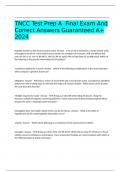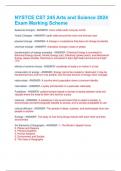Nur 213 Exam 3 With Questions And Correct
Answers Latest Version
Many patients, families, and clinicians see death as what happens when Answer: medicine fails
End-of-Life Care (Hospice care): Answer: Addresses comprehensive symptom management
Psychosocial care
Spiritual support
Typically done in outpatient setting (home health) or inpatient facility (limited number)
QUALITY of life
ALWAYS the goal for clients, it is no different in end-of-life care Answer: Autonomy
Closed awareness Answer: patient is unaware of their terminal state
Suspected awareness Answer: patient suspects others know and attempts to find out details
Mutual pretense awareness Answer: patient, family, and health care professionals are aware that
the patient is dying, but pretend otherwise
Open awareness Answer: patient, family, and health care professionals are aware that the patient is
dying and openly acknowledge this reality
Hospice care Answer: Death must be accepted.
2024
,The patient's total care is best managed by an interdisciplinary team whose members communicate
regularly with one another.
Pain and other symptoms of terminal illness must be managed.
The patient and the family should be viewed as a single unit of care.
Home care of the dying is necessary.
Bereavement care must be provided to family members.
Research and education should be ongoing.
General Answer: Serious, progressive illness
Limited life expectancy
Informed choice of palliative care over cure-focused treatment
Hospice Specific Answer: Presence of a family member or other caregiver continuously in the home
when the patient is no longer able to safely care for himself or herself (some hospices have created
special services within their programs for patients who live alone, although this varies widely).
Medicare and Medicaid Hospice Benefits Answer: Medicare Part A; Medical Assistance eligibility
Waiver of traditional Medicare/Medicaid benefits for the terminal illness
Life expectancy of ≤6 months
Physician certification of terminal illness
Care must be provided by a Medicare-certified hospice program
Routine home care: Answer: All services provided are included in the daily rate to the hospice.
Inpatient respite care: Answer: A 5-day inpatient stay, provided on an occasional basis to relieve the
family caregivers.
2024
,Continuous care: Answer: Continuous nursing care provided in the home for the management of a
medical crisis. Care reverts to the routine home care level after the crisis is resolved. (For example,
seizure activity develops and a nurse is placed in the home continuously to monitor the patient and
administer medications. After 72 hours, the seizure activity is under control, the family has been
instructed how to care for the patient, and the continuous nursing care is discontinued.)
General inpatient care: Answer: Inpatient stay for symptom management that cannot be provided
in the home. This is not subject to the guidelines for a standard hospital inpatient stay.
Nurses assist with Answer: life review, values clarification, treatment decision making, and end-of-
life goals
Nurses must be aware Answer: of their own attitudes about death so that communication can be
more effective.
Communication: Answer: Active listening; especially during time of diagnosis, disease-focused
treatment failures, effectiveness of a particular intervention, and decisions about hospice care.
Patience, empathy, honesty are key
Resist the impulse to fill the "empty space" in communication with talk.
Allow the patient and the family sufficient time to reflect and respond after asking a question.
Prompt gently: "Do you need more time to think about this?"
Avoid distractions (noise, interruptions).
Avoid the impulse to give advice.
Avoid canned responses: "I know just how you feel."
Ask questions.
Assess understanding—your own and the patient's—by restating, summarizing, and reviewing.
2024
, The nurse's role of caring for terminally ill Answer: Assess values, preferences, and practices of
every patient, regardless of ethnicity, socioeconomic status, or background.
Assess and document the patient's and family's specific beliefs, preferences, and practices regarding end
of life care, preparation for death, and after-death rituals.
Use judgment and discretion about timing and setting for eliciting this information
Assessment of end-of-life beliefs, preferences, and practices should be carried out in short segments
over a period of time
Newer nurses can learn a lot from more experienced nurses when discussing these
Awareness of diagnosis, illness stage, and prognosis: Answer: Tell me your understanding of your
illness right now
•Values: Answer: "Tell me what is most important to you as you are thinking about the treatment
options available to you/your loved one."
Preferences Answer: "You've said that being comfortable and pain free is most important to you
right now. Where would you like to receive care (home, hospital, long-term care facility, doctor's office),
and how can I help?"
Expected/desired outcomes: Answer: "What are your hopes and expectations for this (diagnostic
test [e.g., CT scan] or treatment)?"
Benefits and burdens: Answer: "Is there a point at which you would say that the testing or
treatment is outweighed by the burdens it is causing you (e.g., getting from home to the hospital, pain,
nausea, fatigue, interference with other important activities)?"
Spiritual care Answer: The harmony or discord between the patient's and the family's beliefs
Other sources of meaning, hope, and comfort
The presence or absence of a sense of peace of mind and purpose in life
2024





